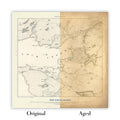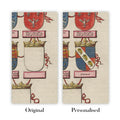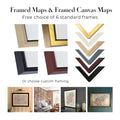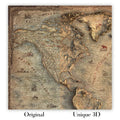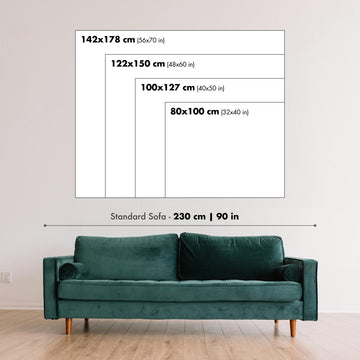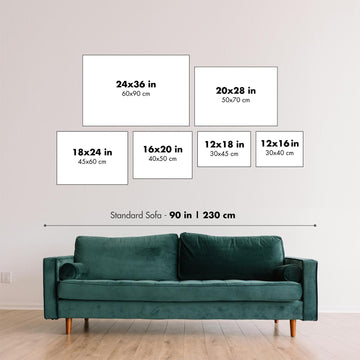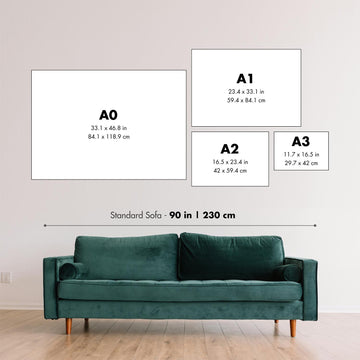

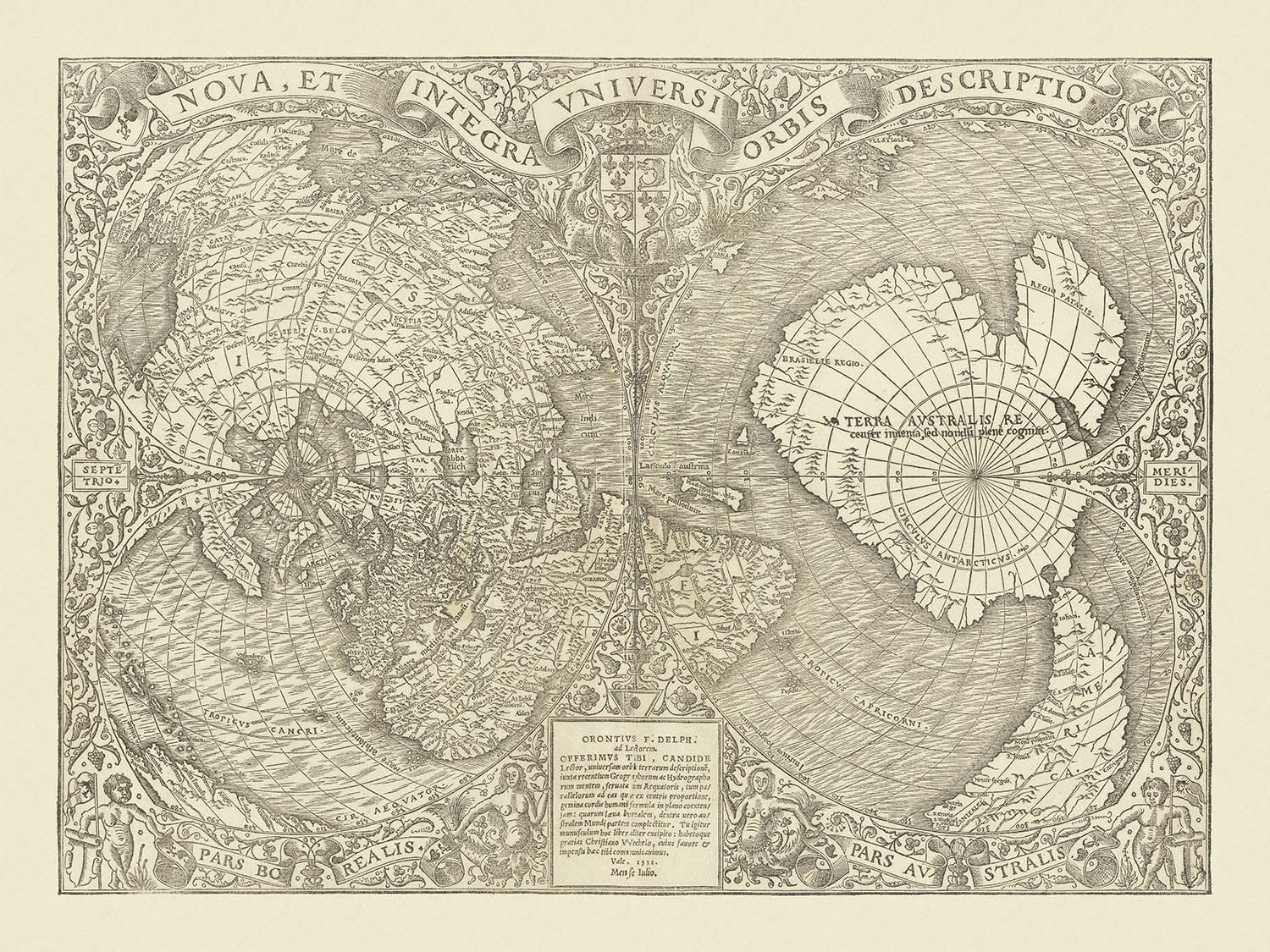

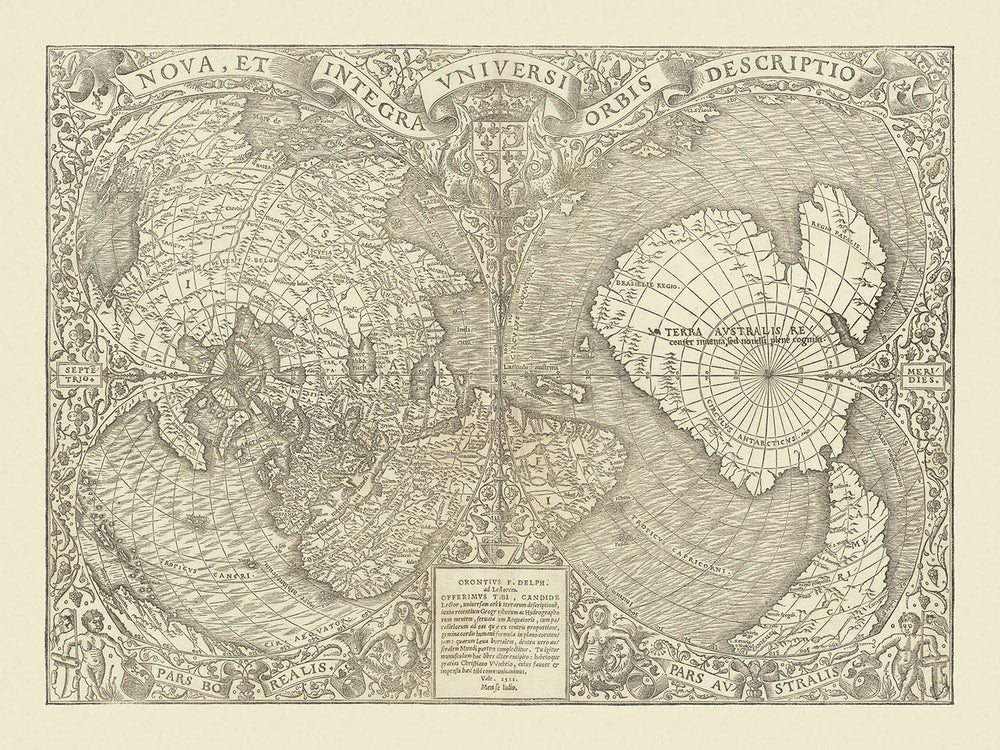

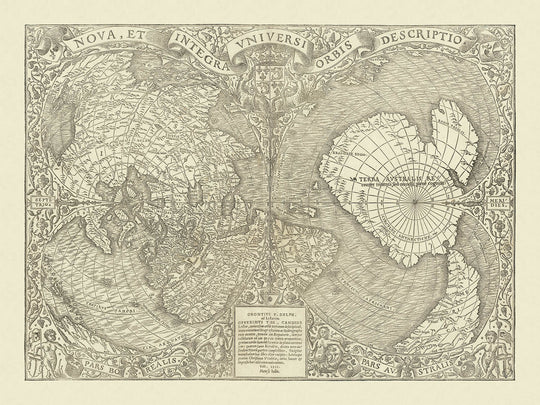








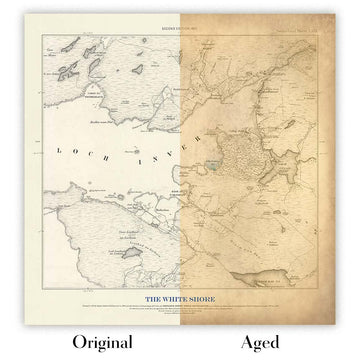
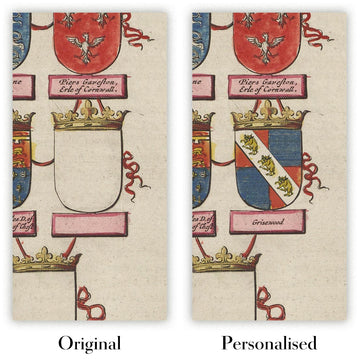
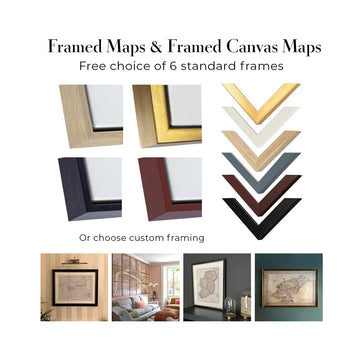


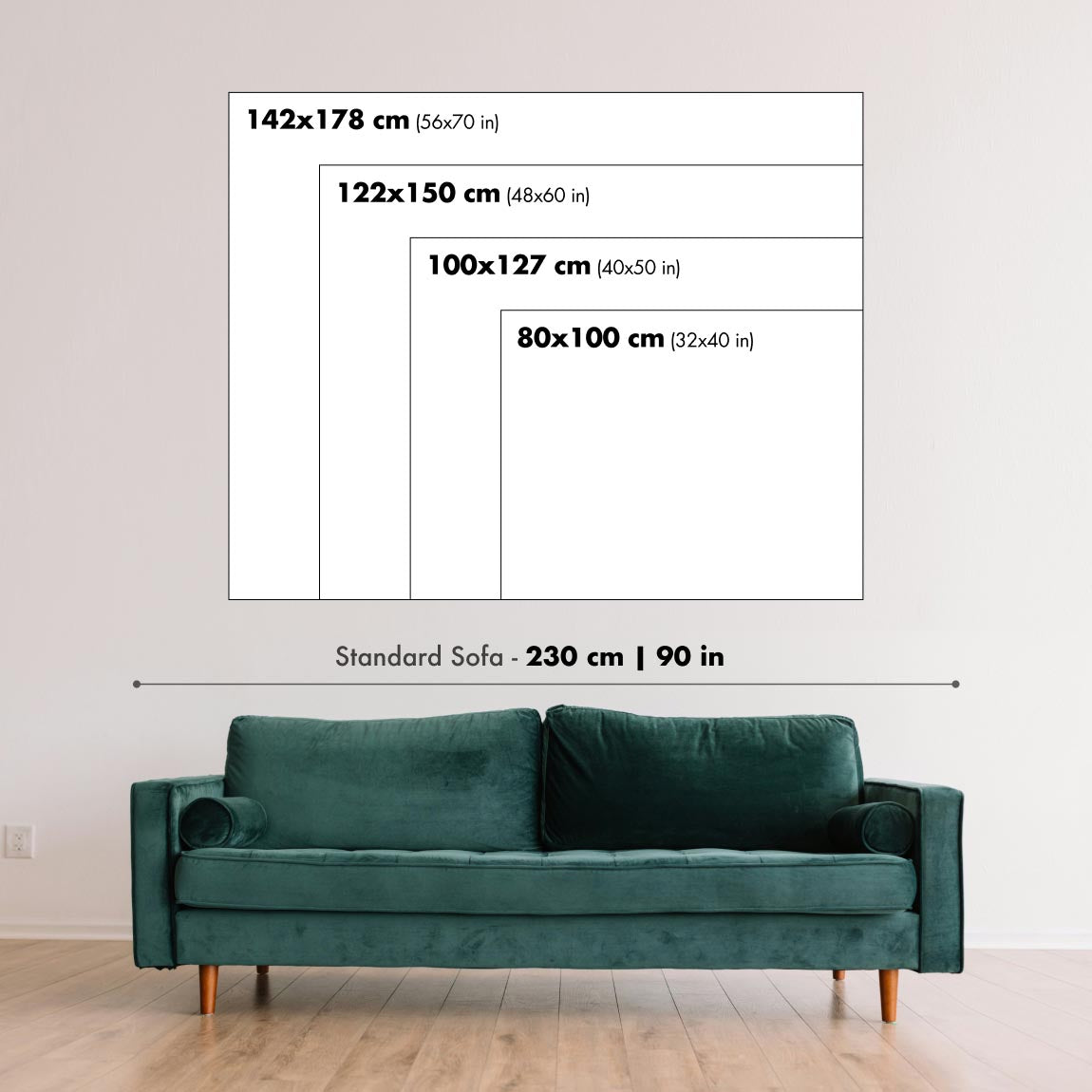
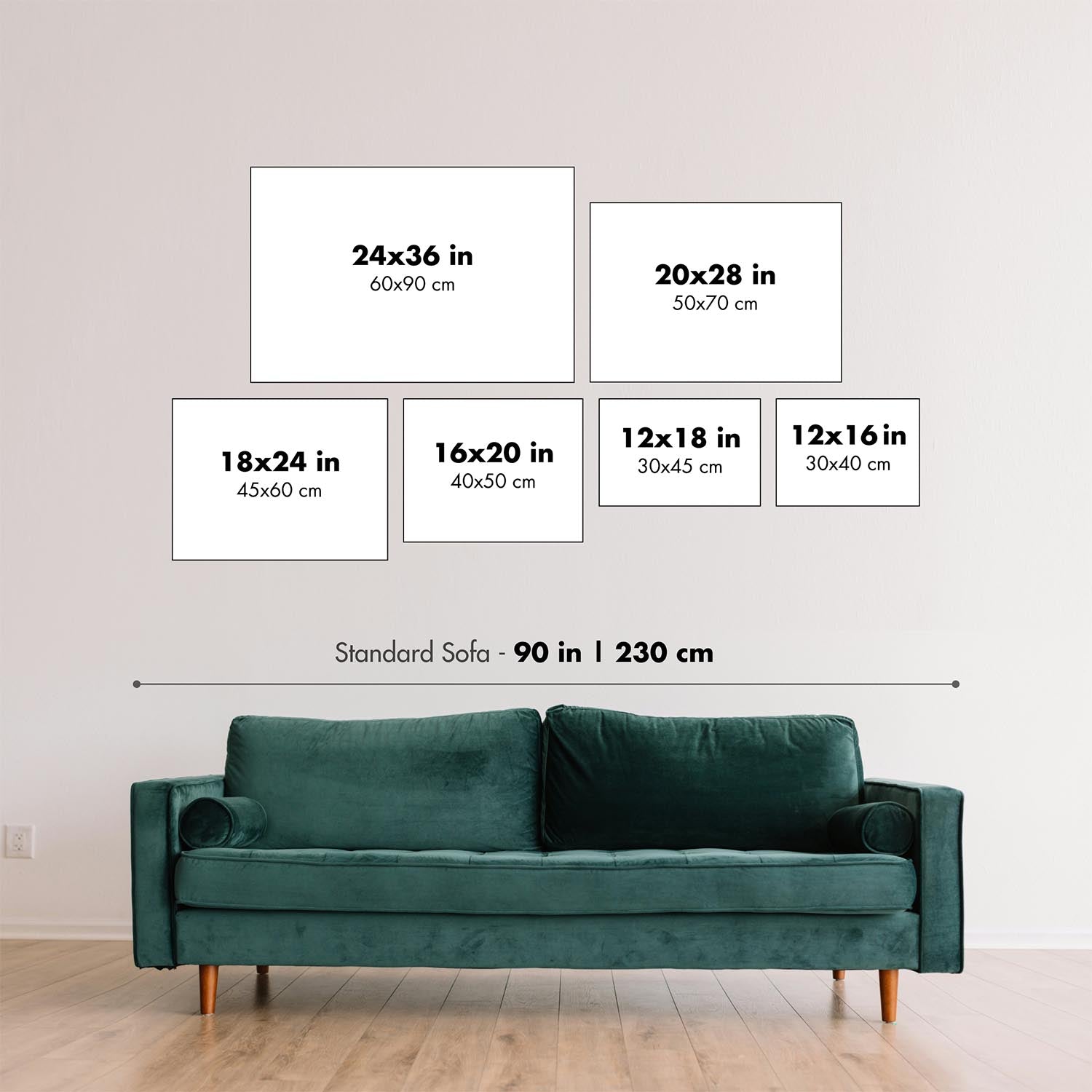
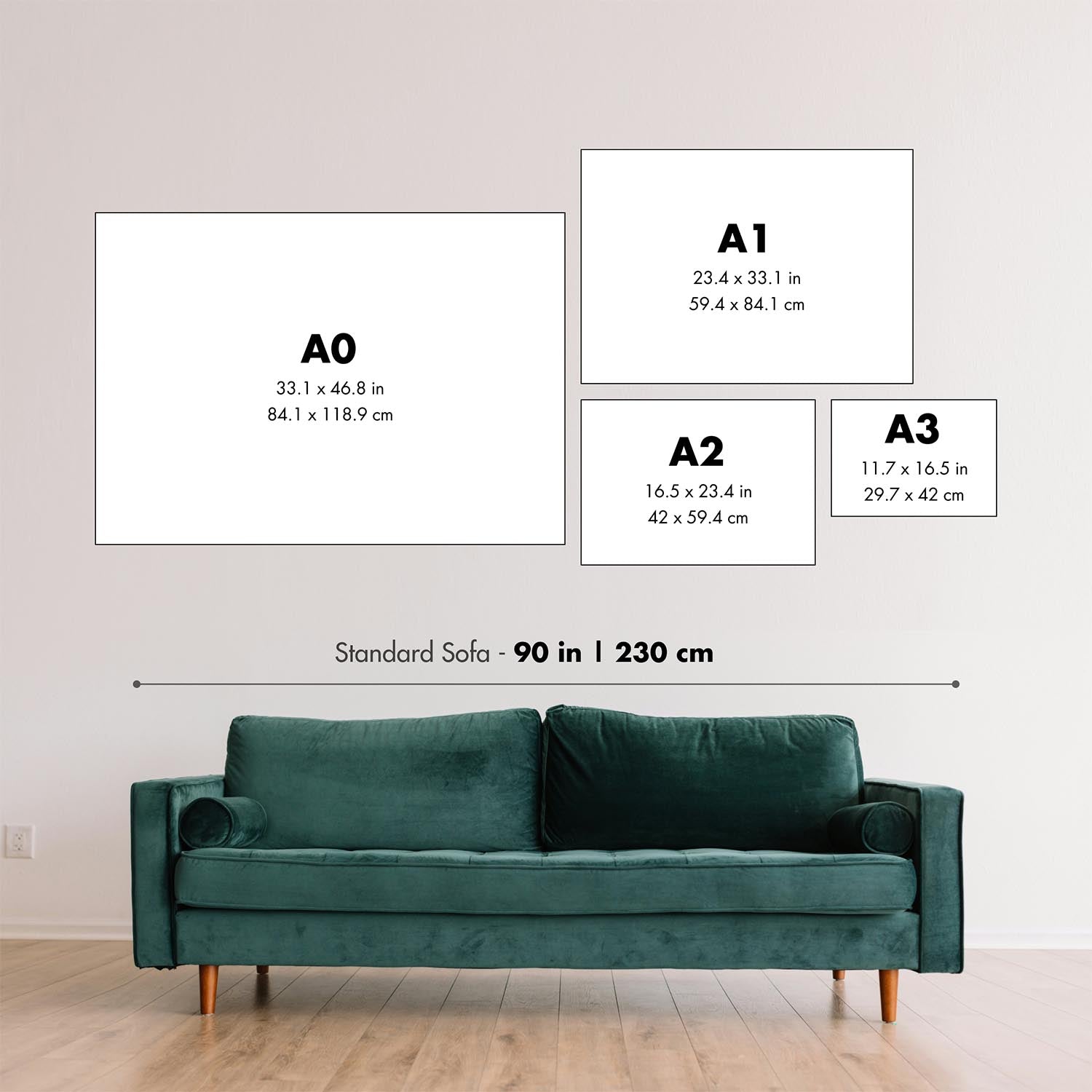
Old Double Cordiform Magellanic World Map by Oronce Fine, 1531: Magellan’s Sea, Terra Australis
- All taxes and duties included
- Handmade & dispatched in 1-2 days
-
90 day money back guarantee
ⓘ
90 días para devolver y reembolsar
Los productos se pueden devolver dentro de los 90 días para un reembolso completo, o cambio por otro producto.
Para artículos personalizados o hechos a medida, podemos ofrecerte un crédito en la tienda o una tarjeta de regalo que no caduca, ya que no podemos revender pedidos personalizados.
Si tienes alguna pregunta, ponte en contacto. Para más información, consulta nuestra política de devoluciones y cambios.

My maps are rare, museum-grade, restored old maps sourced from libraries, auction houses and private collections across the globe.
Framing & free personalisation available
1. Select your size
➢ Pick the closest size (above)
➢ Provide the exact size in millimetres
➢ Add to bag and checkout as normal
2. Frame & personalise your map
Make your map unique with framing, hand-drawn customisation, vintage ageing, pop art text, unique 3D styling and moreMensaje de regalo y acabado personalizado

Si deseas agregar un mensaje de regalo, o un acabado (rompecabezas, tablero de aluminio, etc.) que no esté disponible aquí, por favor solicítalo en la "nota del pedido" cuando realices la compra.
Cada pedido es hecho a medida, así que si necesitas que el tamaño se ajuste ligeramente, o que se imprima en un material inusual, háznoslo saber. Hemos realizado miles de pedidos personalizados a lo largo de los años, así que hay (casi) nada que no podamos gestionar.
También puedes contactarnos antes de hacer tu pedido, ¡si lo prefieres!

- Handmade locally. No import duty or tax
- FREE Delivery. Arrives in 2-3 days
- Love it or your money back
- Questions? WhatsApp me any time
Own a piece of history
5,000+ 5 star reviews


Step into the fascinating world of Renaissance cartography with Oronce Fine’s “Nova, et Integra Universi Orbis Descriptio,” a masterwork first published in 1531. This extraordinary map, the earliest known double cordiform (heart-shaped) projection of the world, stands as a testament to both the ambition and artistry of early modern mapmakers. Fine, an eminent French mathematician and geographer, ingeniously synthesized the latest discoveries of his era—most notably the voyages of Magellan and Cortez—into a vision of the globe that was both scientifically advanced and visually arresting. The map’s original Latin title, which translates to “A New and Complete Description of the Whole World,” perfectly encapsulates its groundbreaking scope and the spirit of exploration that defined the age.
Created at a time when the boundaries of the known world were rapidly expanding, Fine’s map captures the excitement and uncertainty of the early sixteenth century. It is one of the very first maps to mention the “Mare magellanicum,” honoring Ferdinand Magellan’s epochal circumnavigation. The map boldly delineates the mysterious Terra Australis—“recently discovered but not yet explored”—a vast southern continent that would tantalize explorers and geographers for centuries. Central America is richly annotated with place names reflecting the conquests and explorations of Cortez, while the North American continent is intriguingly rendered as an extension of Asia, revealing the evolving European understanding of global geography.
The map’s double cordiform projection is a marvel of geometric ingenuity, reducing the spherical earth to two elegantly interlocking heart-shaped lobes. This unique format, devised by Fine himself, would become a model for world maps for decades to follow, preceding the rise of oval and double-hemispheric projections and the eventual dominance of Mercator’s projection. The projection not only serves as a technical achievement but also imbues the map with a sense of harmony and unity, inviting the viewer to contemplate the interconnectedness of the world’s continents and oceans.
Aesthetically, Fine’s map is a triumph of Renaissance artistry. The detailed woodcut is framed by a lush floral border, flanked by two mermaids and muscular cherubs that evoke the mythic and the maritime. The French royal coat of arms is displayed with pride, while a flowing banner at the top proclaims the map’s title. The lower cartouche bears Fine’s own name, marking this as the coveted first state of the map—a rare and desirable feature for collectors and connoisseurs. Every element, from the ornate border to the meticulously engraved landmasses, reflects the humanist ideals and decorative sensibilities of its time.
Within its intricate design, the map reveals a world both familiar and fantastical. Greenland is shown as a separate island, while the Arctic is depicted as four enigmatic islands. The promontory labeled “Gaccalar”—thought to represent Labrador—juts boldly into the Atlantic. Mountain ranges, rivers, and coastlines are rendered with a detail that speaks to Fine’s dedication to accuracy, even as the limits of contemporary knowledge left vast regions shrouded in mystery. This map is not merely a record of the world as it was known in 1531; it is a celebration of discovery, imagination, and the enduring quest to chart the unknown.
Countries and regions on this map
- Europe
- Asia
- Africa
- America (North and South America, with North America depicted as part of Asia)
- Terra Australis (Southern continent, not yet explored)
- Greenland
- Gaccalar (Labrador)
- Central America (with specific place names from early Spanish exploration)
- Mare magellanicum (Magellan’s Sea, body of water)
- Arctic region (depicted as four islands)
Notable Features & Landmarks
- Double cordiform (heart-shaped) projection, split into two lobes
- Decorative floral border surrounding the map
- Two mermaids illustrated outside the map
- Two muscular cherubs (putti) depicted outside the map
- French royal coat of arms displayed prominently
- Flowing banner with the map’s title at the top
- Lower cartouche with Oronce Fine’s name (Orontius F. Delph)
- Mare magellanicum (Magellan’s Sea) labelled beyond the tip of South America
- Terra Australis ("recently discovered but not yet explored") occupies much of the southern lobe
- Four islands depicted at the North Pole
- Separate island labelled as Greenland
- Large promontory labelled Gaccalar (supposedly Labrador) extending from North America
- Numerous place names in Central America reflecting early Spanish exploration
- Detailed physical features such as mountain ranges and rivers
Historical and design context
- First double cordiform (heart-shaped) world map ever produced
- Created by Oronce Fine, an eminent French cartographer and mathematician, in 1531
- One of the earliest maps to mention Magellan (Mare magellanicum)
- Became a model for world maps for several decades before the rise of oval and double-hemispheric projections, and Mercator’s projection
- Based on sophisticated geometric principles for depicting the spherical earth in two dimensions
- Detailed woodcut with Renaissance artistry and humanist ideals
- First appeared in the 1532 Paris edition of Johann Huttich and Simon Grynaeus's Novus orbis regionum
- The first state of the map, the only one to feature Oronce Fine’s name in the lower cartouche
- Celebrates the spirit of exploration and discovery during the early sixteenth century
Please double check the images to make sure that a specific town or place is shown on this map. You can also get in touch and ask us to check the map for you.
This map looks great at every size, but I always recommend going for a larger size if you have space. That way you can easily make out all of the details.
This map looks amazing at sizes all the way up to 70in (180cm). If you are looking for a larger map, please get in touch.
The model in the listing images is holding the 18x24in (45x60cm) version of this map.
The fifth listing image shows an example of my map personalisation service.
If you’re looking for something slightly different, check out my collection of the best old maps to see if something else catches your eye.
Please contact me to check if a certain location, landmark or feature is shown on this map.
This would make a wonderful birthday, Christmas, Father's Day, work leaving, anniversary or housewarming gift for someone from the areas covered by this map.
This map is available as a giclée print on acid free archival matte paper, or you can buy it framed. The frame is a nice, simple black frame that suits most aesthetics. Please get in touch if you'd like a different frame colour or material. My frames are glazed with super-clear museum-grade acrylic (perspex/acrylite), which is significantly less reflective than glass, safer, and will always arrive in perfect condition.
This map is also available as a float framed canvas, sometimes known as a shadow gap framed canvas or canvas floater. The map is printed on artist's cotton canvas and then stretched over a handmade box frame. We then "float" the canvas inside a wooden frame, which is available in a range of colours (black, dark brown, oak, antique gold and white). This is a wonderful way to present a map without glazing in front. See some examples of float framed canvas maps and explore the differences between my different finishes.
For something truly unique, this map is also available in "Unique 3D", our trademarked process that dramatically transforms the map so that it has a wonderful sense of depth. We combine the original map with detailed topography and elevation data, so that mountains and the terrain really "pop". For more info and examples of 3D maps, check my Unique 3D page.
Para la mayoría de los pedidos, el tiempo de entrega es de aproximadamente 3 días laborables. Los productos personalizados y a medida tardan más, ya que tengo que hacer la personalización y enviártelo para su aprobación, lo cual suele tardar 1 o 2 días.
Tenga en cuenta que los pedidos enmarcados muy grandes suelen tardar más en fabricarse y entregarse.
Si necesitas que tu pedido llegue para una fecha determinada, por favor contáctame antes de hacer el pedido para que podamos encontrar la mejor manera de asegurarnos de que recibas tu pedido a tiempo.
Imprimo y enmarco mapas y obras de arte en 23 países alrededor del mundo. Esto significa que tu pedido se fabricará localmente, lo que reduce el tiempo de entrega y asegura que no se dañe durante el envío. Nunca pagarás aranceles de aduana o impuestos de importación, y pondremos menos CO2 en el aire.
Todos mis mapas y impresiones artísticas están bien empaquetados y enviados en un tubo resistente si no están enmarcados, o rodeados de espuma si están enmarcados.
Intento enviar todos los pedidos dentro de 1 o 2 días después de recibir tu pedido, aunque algunos productos (como mascarillas, tazas y bolsas de tela) pueden tardar más en fabricarse.
Si seleccionas Entrega Exprés al finalizar la compra, priorizaremos tu pedido y lo enviaremos por mensajería de 1 día (Fedex, DHL, UPS, Parcelforce).
La entrega al día siguiente también está disponible en algunos países (EE. UU., Reino Unido, Singapur, EAU), pero por favor intenta hacer tu pedido temprano en el día para que podamos enviarlo a tiempo.
Mi marco estándar es un marco de madera de fresno negro estilo galería. Es simple y tiene un aspecto bastante moderno. Mi marco estándar tiene alrededor de 20 mm (0.8 in) de ancho.
Utilizo acrílico super claro (perspex/acrylite) para el vidrio del marco. Es más ligero y seguro que el vidrio, y se ve mejor, ya que la reflectividad es menor.
Seis colores de marco estándar están disponibles de forma gratuita (negro, marrón oscuro, gris oscuro, roble, blanco y oro antiguo).El enmarcado y montaje/matizado personalizado está disponible si buscas algo diferente.
La mayoría de los mapas, arte e ilustraciones también están disponibles como un lienzo enmarcado. Utilizamos lienzo de algodón mate (no brillante), lo estiramos sobre un marco de madera de caja de origen sostenible, y luego 'flotamos' la pieza dentro de un marco de madera. El resultado final es bastante hermoso, y no hay cristal que se interponga.
Todos los marcos se proporcionan "listos para colgar", con una cuerda o soportes en la parte posterior. Los marcos muy grandes tendrán placas de colgar de alta resistencia y/o un listón de montaje. Si tienes alguna pregunta, por favor ponte en contacto.
Mira algunos ejemplos de mis mapas enmarcados y mapas en lienzo enmarcados.
Alternativamente, también puedo proporcionar mapas antiguos y obras de arte en lienzo, tablero de espuma, papel de algodón y otros materiales.
Si deseas enmarcar tu mapa o obra de arte tú mismo, por favor lee mi guía de tamaños primero.
Algunos de mis mapas antiguos ahora están disponibles como lienzos enmarcados. Por favor contáctame si deseas pedir un tamaño que no está disponible en mi tienda.
Los mapas antiguos en lienzo son una alternativa interesante a los mapas enmarcados convencionalmente. Dependiendo de tu gusto personal y la decoración de la habitación, los mapas en lienzo pueden "destacar" un poco más que un mapa enmarcado.
Mis mapas son reproducciones de mapas originales de altísima calidad.
Obtengo mapas originales y raros de bibliotecas, casas de subastas y colecciones privadas de todo el mundo, los restauro en mi taller de Londres y luego uso tintas e impresoras giclée especializadas para crear hermosos mapas que lucen incluso mejor que el original.
Mis mapas están impresos en papel de archivo mate (no brillante) sin ácido que se siente de muy alta calidad y casi como una tarjeta. En términos técnicos, el peso/grosor del papel es de 10 mil/200 g/m². Es perfecto para enmarcar.
Imprimo con tintas pigmentadas Epson ultrachrome giclée UV resistentes a la decoloración, algunas de las mejores tintas que puedes encontrar.
yo también puedo hacer mapas sobre lienzo, trapo de algodón y otros materiales exóticos.
Obtenga más información sobre The Unique Maps Co..
Personalización de mapas
Si está buscando el regalo perfecto de aniversario o inauguración de la casa, puedo personalizar su mapa para hacerlo verdaderamente único. Por ejemplo, puedo agregar un mensaje corto, resaltar una ubicación importante o agregar el escudo de armas de su familia.
Las opciones son casi infinitas. Por favor mira mi página de personalización de mapas para ver algunos maravillosos ejemplos de lo que es posible.
Para pedir un mapa personalizado, seleccione "personalizar su mapa" antes de agregarlo a su carrito.
Ponerse en contacto si buscas personalizaciones y personalizaciones más complejas.
Envejecimiento del mapa
A lo largo de los años, los clientes me han preguntado cientos de veces si podían comprar un mapa que se viera uniforme. más viejo.
Bueno, ahora puedes hacerlo seleccionando Envejecido antes de agregar un mapa a tu carrito.
Todas las fotografías de productos que ve en esta página muestran el mapa en su forma original. Así es como se ve el mapa hoy.
Si selecciona Envejecido, envejeceré su mapa a mano, usando un proceso especial y único desarrollado a través de años de estudiar mapas antiguos, hablar con investigadores para comprender la química del envejecimiento del papel y, por supuesto... ¡mucha práctica!
Si no estás seguro, quédate con el color original del mapa. Si quieres algo un poco más oscuro y más viejo buscando, opte por Envejecido.
Si no estás satisfecho con tu pedido por cualquier motivo, contáctame para un reembolso sin complicaciones. Por favor, consulta nuestra política de devoluciones y reembolsos para más información.
Estoy muy seguro de que te gustará tu mapa o impresión artística restaurada. He estado haciendo esto desde 1984. Soy un vendedor de 5 estrellas en Etsy. He vendido decenas de miles de mapas e impresiones artísticas y tengo más de 5,000 opiniones reales de 5 estrellas.
Utilizo un proceso único para restaurar mapas y obras de arte que consume mucho tiempo y mano de obra. Buscar los mapas e ilustraciones originales puede llevar meses. Utilizo tecnología de última generación y extremadamente cara para escanear y restaurarlos. Como resultado, garantizo que mis mapas e impresiones artísticas son superiores a los demás - por eso puedo ofrecer un reembolso sin complicaciones.
Casi todos mis mapas e impresiones artísticas se ven increíbles en tamaños grandes (200cm, 6.5ft+) y también puedo enmarcarlos y entregártelos a través de un servicio de mensajería especial para tamaños grandes. Contáctame para discutir tus necesidades específicas.
Or try searching for something!
Este servicio no está disponible actualmente,
disculpe las molestias.
Combínalo con un marco
Las opciones de marco son solo para fines de visualización.
ESTILO DEL MARCO
TAMAÑO DEL MATE
CREANDO TU EXPERIENCIA
powered by Blankwall
¿Fue útil esta experiencia?
Step into the fascinating world of Renaissance cartography with Oronce Fine’s “Nova, et Integra Universi Orbis Descriptio,” a masterwork first published in 1531. This extraordinary map, the earliest known double cordiform (heart-shaped) projection of the world, stands as a testament to both the ambition and artistry of early modern mapmakers. Fine, an eminent French mathematician and geographer, ingeniously synthesized the latest discoveries of his era—most notably the voyages of Magellan and Cortez—into a vision of the globe that was both scientifically advanced and visually arresting. The map’s original Latin title, which translates to “A New and Complete Description of the Whole World,” perfectly encapsulates its groundbreaking scope and the spirit of exploration that defined the age.
Created at a time when the boundaries of the known world were rapidly expanding, Fine’s map captures the excitement and uncertainty of the early sixteenth century. It is one of the very first maps to mention the “Mare magellanicum,” honoring Ferdinand Magellan’s epochal circumnavigation. The map boldly delineates the mysterious Terra Australis—“recently discovered but not yet explored”—a vast southern continent that would tantalize explorers and geographers for centuries. Central America is richly annotated with place names reflecting the conquests and explorations of Cortez, while the North American continent is intriguingly rendered as an extension of Asia, revealing the evolving European understanding of global geography.
The map’s double cordiform projection is a marvel of geometric ingenuity, reducing the spherical earth to two elegantly interlocking heart-shaped lobes. This unique format, devised by Fine himself, would become a model for world maps for decades to follow, preceding the rise of oval and double-hemispheric projections and the eventual dominance of Mercator’s projection. The projection not only serves as a technical achievement but also imbues the map with a sense of harmony and unity, inviting the viewer to contemplate the interconnectedness of the world’s continents and oceans.
Aesthetically, Fine’s map is a triumph of Renaissance artistry. The detailed woodcut is framed by a lush floral border, flanked by two mermaids and muscular cherubs that evoke the mythic and the maritime. The French royal coat of arms is displayed with pride, while a flowing banner at the top proclaims the map’s title. The lower cartouche bears Fine’s own name, marking this as the coveted first state of the map—a rare and desirable feature for collectors and connoisseurs. Every element, from the ornate border to the meticulously engraved landmasses, reflects the humanist ideals and decorative sensibilities of its time.
Within its intricate design, the map reveals a world both familiar and fantastical. Greenland is shown as a separate island, while the Arctic is depicted as four enigmatic islands. The promontory labeled “Gaccalar”—thought to represent Labrador—juts boldly into the Atlantic. Mountain ranges, rivers, and coastlines are rendered with a detail that speaks to Fine’s dedication to accuracy, even as the limits of contemporary knowledge left vast regions shrouded in mystery. This map is not merely a record of the world as it was known in 1531; it is a celebration of discovery, imagination, and the enduring quest to chart the unknown.
Countries and regions on this map
- Europe
- Asia
- Africa
- America (North and South America, with North America depicted as part of Asia)
- Terra Australis (Southern continent, not yet explored)
- Greenland
- Gaccalar (Labrador)
- Central America (with specific place names from early Spanish exploration)
- Mare magellanicum (Magellan’s Sea, body of water)
- Arctic region (depicted as four islands)
Notable Features & Landmarks
- Double cordiform (heart-shaped) projection, split into two lobes
- Decorative floral border surrounding the map
- Two mermaids illustrated outside the map
- Two muscular cherubs (putti) depicted outside the map
- French royal coat of arms displayed prominently
- Flowing banner with the map’s title at the top
- Lower cartouche with Oronce Fine’s name (Orontius F. Delph)
- Mare magellanicum (Magellan’s Sea) labelled beyond the tip of South America
- Terra Australis ("recently discovered but not yet explored") occupies much of the southern lobe
- Four islands depicted at the North Pole
- Separate island labelled as Greenland
- Large promontory labelled Gaccalar (supposedly Labrador) extending from North America
- Numerous place names in Central America reflecting early Spanish exploration
- Detailed physical features such as mountain ranges and rivers
Historical and design context
- First double cordiform (heart-shaped) world map ever produced
- Created by Oronce Fine, an eminent French cartographer and mathematician, in 1531
- One of the earliest maps to mention Magellan (Mare magellanicum)
- Became a model for world maps for several decades before the rise of oval and double-hemispheric projections, and Mercator’s projection
- Based on sophisticated geometric principles for depicting the spherical earth in two dimensions
- Detailed woodcut with Renaissance artistry and humanist ideals
- First appeared in the 1532 Paris edition of Johann Huttich and Simon Grynaeus's Novus orbis regionum
- The first state of the map, the only one to feature Oronce Fine’s name in the lower cartouche
- Celebrates the spirit of exploration and discovery during the early sixteenth century
Please double check the images to make sure that a specific town or place is shown on this map. You can also get in touch and ask us to check the map for you.
This map looks great at every size, but I always recommend going for a larger size if you have space. That way you can easily make out all of the details.
This map looks amazing at sizes all the way up to 70in (180cm). If you are looking for a larger map, please get in touch.
The model in the listing images is holding the 18x24in (45x60cm) version of this map.
The fifth listing image shows an example of my map personalisation service.
If you’re looking for something slightly different, check out my collection of the best old maps to see if something else catches your eye.
Please contact me to check if a certain location, landmark or feature is shown on this map.
This would make a wonderful birthday, Christmas, Father's Day, work leaving, anniversary or housewarming gift for someone from the areas covered by this map.
This map is available as a giclée print on acid free archival matte paper, or you can buy it framed. The frame is a nice, simple black frame that suits most aesthetics. Please get in touch if you'd like a different frame colour or material. My frames are glazed with super-clear museum-grade acrylic (perspex/acrylite), which is significantly less reflective than glass, safer, and will always arrive in perfect condition.








